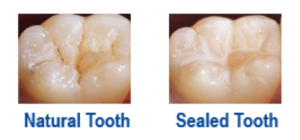Sealants
A sealant is a thin, plastic coating applied to the chewing surface of molars, premolars and any deep grooves (called pits and fissures) of teeth. More than 75% of dental decay begins in these deep grooves. Teeth with these conditions are hard to clean and are very susceptible to decay. A sealant protects the tooth by sealing deep grooves, creating a smooth, easy to clean surface. Sealants can protect teeth from decay for many years, but need to be checked for wear and chipping at regular dental visits.

Which teeth are suitable for sealants?
Permanent molars are the most likely to benefit from sealant application. First molars usually come into the mouth when a child is about 6 years of age. Second molars appear at about age 12. It is best if the sealant is applied soon after the molars have erupted, before the teeth have a chance to decay. For that reason, children between the ages of 5 and 15 benefit most from sealants.
How are sealants applied?
Applying sealants does not require drilling. It is an easy three-step process: A dentist or dental hygienist cleans the tooth with a special toothpaste. A special cleansing liquid, on a tiny piece of cotton, is rubbed gently on the tooth and is washed off. Finally, the sealant is painted on the tooth. It takes about a minute for the sealant to form a protective shield.
What are the benefits of sealants?
Sealants are slippery and make it harder for plaque that causes decay to stick in the pits and grooves of molars. Because sealants can prevent more than 80% of dental decay in children, they reduce the need for fillings and other more expensive treatment. Sealants are an economical preventive measure to keep teeth healthy for years.
How long will sealants last?
One sealant application can last for as long as 5 to 10 years. Sealants should be checked regularly, and reapplied if they are no longer in place.

